Azure networking services overview
The networking services in Azure provide various networking capabilities that can be used together or separately. Select any of the following key capabilities to learn more about them:
- Connectivity services: Connect Azure resources and on-premises resources using any or a combination of these networking services in Azure - Virtual Network (VNet), Virtual WAN, ExpressRoute, VPN Gateway, NAT Gateway, Azure DNS, Peering service, Azure Virtual Network Manager, Route Server, and Azure Bastion.
- Application protection services: Protect your applications using any or a combination of these networking services in Azure - Load Balancer, Private Link, DDoS protection, Firewall, Network Security Groups, Web Application Firewall, and Virtual Network Endpoints.
- Application delivery services: Deliver applications in the Azure network using any or a combination of these networking services in Azure - Content Delivery Network (CDN), Azure Front Door Service, Traffic Manager, Application Gateway, Internet Analyzer, and Load Balancer.
- Network monitoring: Monitor your network resources using any or a combination of these networking services in Azure - Network Watcher, ExpressRoute Monitor, Azure Monitor, or VNet Terminal Access Point (TAP).
Connectivity services
This section describes services that provide connectivity between Azure resources, connectivity from an on-premises network to Azure resources, and branch to branch connectivity in Azure - Virtual Network (VNet), ExpressRoute, VPN Gateway, Virtual WAN, Virtual network NAT Gateway, Azure DNS, Peering service, Route Server, and Azure Bastion.
Virtual network
Azure Virtual Network (VNet) is the fundamental building block for your private network in Azure. You can use VNets to:
- Communicate between Azure resources: You can deploy virtual machines, and several other types of Azure resources to a virtual network, such as Azure App Service Environments, the Azure Kubernetes Service (AKS), and Azure Virtual Machine Scale Sets. To view a complete list of Azure resources that you can deploy into a virtual network, see Virtual network service integration.
- Communicate between each other: You can connect virtual networks to each other, enabling resources in either virtual network to communicate with each other, using virtual network peering or Azure Virtual Network Manager. The virtual networks you connect can be in the same, or different, Azure regions. For more information, see Virtual network peering and Azure Virtual Network Manager.
- Communicate to the internet: All resources in a VNet can communicate outbound to the internet, by default. You can communicate inbound to a resource by assigning a public IP address or a public Load Balancer. You can also use Public IP addresses or public Load Balancer to manage your outbound connections.
- Communicate with on-premises networks: You can connect your on-premises computers and networks to a virtual network using VPN Gateway or ExpressRoute.
- Encrypt traffic between resources: You can use Virtual network encryption to encrypt traffic between resources in a virtual network.
Azure Virtual Network Manager
Azure Virtual Network Manager is a management service that enables you to group, configure, deploy, and manage virtual networks globally across subscriptions. With Virtual Network Manager, you can define network groups to identify and logically segment your virtual networks. Then you can determine the connectivity and security configurations you want and apply them across all the selected virtual networks in network groups at once.

ExpressRoute
ExpressRoute enables you to extend your on-premises networks into the Microsoft cloud over a private connection facilitated by a connectivity provider. This connection is private. Traffic doesn't go over the internet. With ExpressRoute, you can establish connections to Microsoft cloud services, such as Microsoft Azure, Microsoft 365, and Dynamics 365.
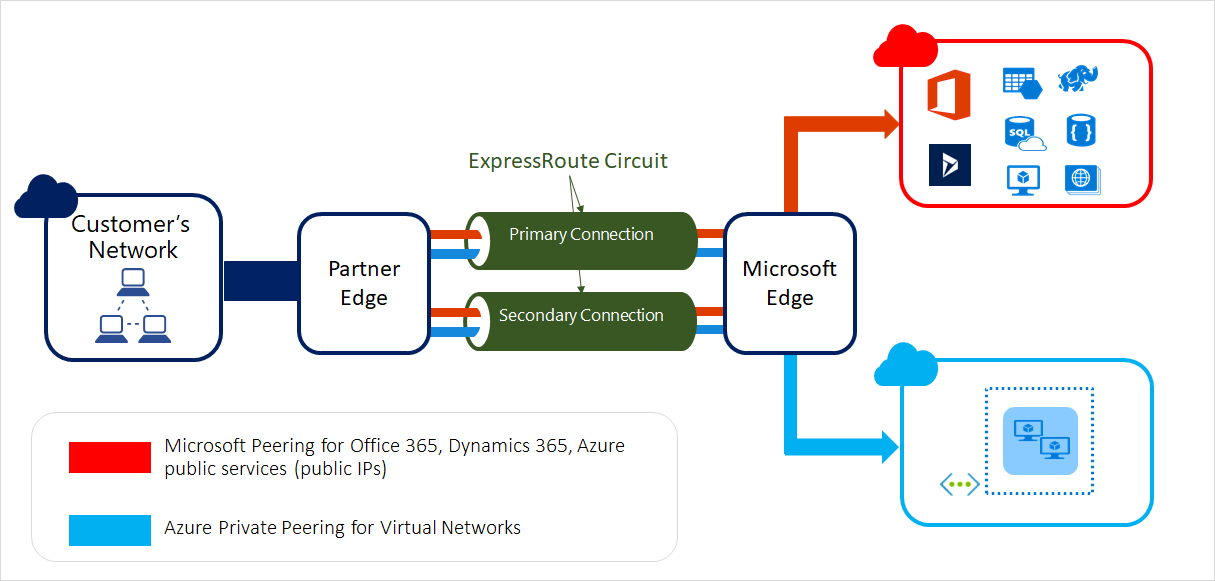
VPN Gateway
VPN Gateway helps you create encrypted cross-premises connections to your virtual network from on-premises locations, or create encrypted connections between VNets. There are different configurations available for VPN Gateway connections. Some of the main features include:
- Site-to-site VPN connectivity
- Point-to-site VPN connectivity
- VNet-to-VNet VPN connectivity
The following diagram illustrates multiple site-to-site VPN connections to the same virtual network. To view more connection diagrams, see VPN Gateway - design.

Virtual WAN
Azure Virtual WAN is a networking service that brings many networking, security, and routing functionalities together to provide a single operational interface. Connectivity to Azure VNets is established by using virtual network connections. Some of the main features include:
- Branch connectivity (via connectivity automation from Virtual WAN Partner devices such as SD-WAN or VPN CPE)
- Site-to-site VPN connectivity
- Remote user VPN connectivity (point-to-site)
- Private connectivity (ExpressRoute)
- Intra-cloud connectivity (transitive connectivity for virtual networks)
- VPN ExpressRoute inter-connectivity
- Routing, Azure Firewall, and encryption for private connectivity
Azure DNS
Azure DNS provides DNS hosting and resolution using the Microsoft Azure infrastructure. Azure DNS consists of three services:
- Azure Public DNS is a hosting service for DNS domains. By hosting your domains in Azure, you can manage your DNS records by using the same credentials, APIs, tools, and billing as your other Azure services.
- Azure Private DNS is a DNS service for your virtual networks. Azure Private DNS manages and resolves domain names in the virtual network without the need to configure a custom DNS solution.
- Azure DNS Private Resolver is a service that enables you to query Azure DNS private zones from an on-premises environment and vice versa without deploying VM based DNS servers.
Using Azure DNS, you can host and resolve public domains, manage DNS resolution in your virtual networks, and enable name resolution between Azure and your on-premises resources.
Azure Bastion
Azure Bastion is a service that you can deploy to let you connect to a virtual machine using your browser and the Azure portal, or via the native SSH or RDP client already installed on your local computer. The Azure Bastion service is a fully platform-managed PaaS service that you deploy inside your virtual network. It provides secure and seamless RDP/SSH connectivity to your virtual machines directly from the Azure portal over TLS. When you connect via Azure Bastion, your virtual machines don't need a public IP address, agent, or special client software. There are a variety of different SKU/tiers available for Azure Bastion. The tier you select affects the features that are available. For more information, see About Bastion configuration settings.

NAT Gateway
Virtual Network NAT(network address translation) simplifies outbound-only Internet connectivity for virtual networks. When configured on a subnet, all outbound connectivity uses your specified static public IP addresses. Outbound connectivity is possible without load balancer or public IP addresses directly attached to virtual machines. For more information, see What is Azure NAT gateway?

Route Server
Azure Route Server simplifies dynamic routing between your network virtual appliance (NVA) and your virtual network. It allows you to exchange routing information directly through Border Gateway Protocol (BGP) routing protocol between any NVA that supports the BGP routing protocol and the Azure Software Defined Network (SDN) in the Azure Virtual Network (VNet) without the need to manually configure or maintain route tables.
Peering Service
Azure Peering Service enhances customer connectivity to Microsoft cloud services such as Microsoft 365, Dynamics 365, software as a service (SaaS) services, Azure, or any Microsoft services accessible via the public internet.
Application protection services
This section describes networking services in Azure that help protect your network resources - Protect your applications using any or a combination of these networking services in Azure - DDoS protection, Private Link, Firewall, Web Application Firewall, Network Security Groups, and Virtual Network Service Endpoints.
DDoS Protection
Azure DDoS Protection provides countermeasures against the most sophisticated DDoS threats. The service provides enhanced DDoS mitigation capabilities for your application and resources deployed in your virtual networks. Additionally, customers using Azure DDoS Protection have access to DDoS Rapid Response support to engage DDoS experts during an active attack.
Azure DDoS Protection consists of two tiers:
- DDoS Network Protection, combined with application design best practices, provides enhanced DDoS mitigation features to defend against DDoS attacks. It's automatically tuned to help protect your specific Azure resources in a virtual network.
- DDoS IP Protection is a pay-per-protected IP model. DDoS IP Protection contains the same core engineering features as DDoS Network Protection, but will differ in the following value-added services: DDoS rapid response support, cost protection, and discounts on WAF.

Azure Private Link
Azure Private Link enables you to access Azure PaaS Services (for example, Azure Storage and SQL Database) and Azure hosted customer-owned/partner services over a private endpoint in your virtual network. Traffic between your virtual network and the service travels through the Microsoft backbone network. Exposing your service to the public internet is no longer necessary. You can create your own private link service in your virtual network and deliver it to your customers.
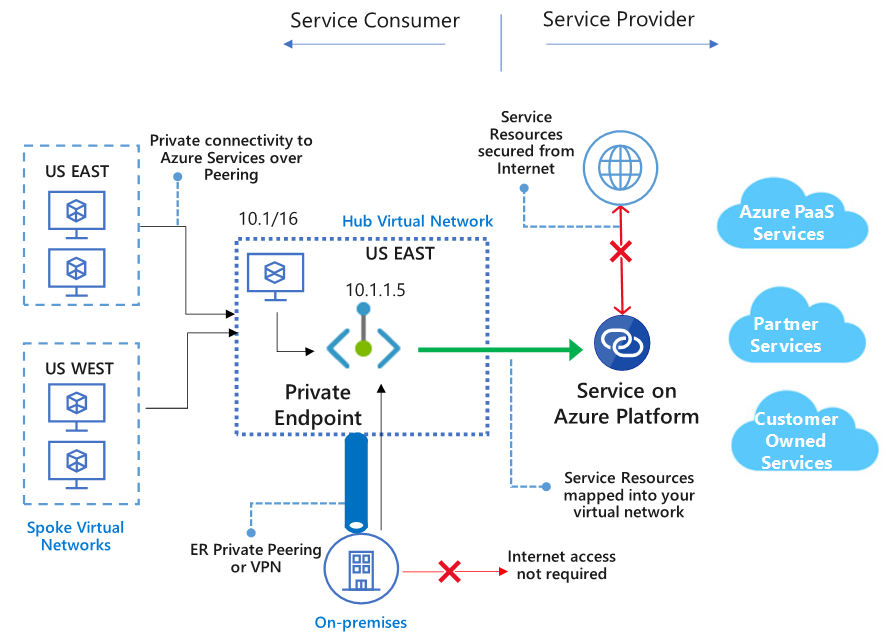
Azure Firewall
Azure Firewall is a managed, cloud-based network security service that protects your Azure Virtual Network resources. Using Azure Firewall, you can centrally create, enforce, and log application and network connectivity policies across subscriptions and virtual networks. Azure Firewall uses a static public IP address for your virtual network resources allowing outside firewalls to identify traffic originating from your virtual network.
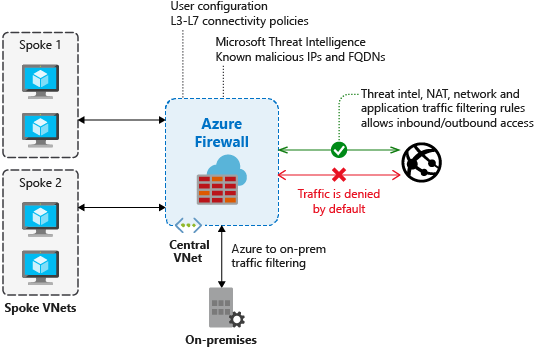
Web Application Firewall
Azure Web Application Firewall (WAF) provides protection to your web applications from common web exploits and vulnerabilities such as SQL injection, and cross site scripting. Azure WAF provides out of box protection from OWASP top 10 vulnerabilities via managed rules. Additionally customers can also configure custom rules, which are customer managed rules to provide extra protection based on source IP range, and request attributes such as headers, cookies, form data fields or query string parameters.
Customers can choose to deploy Azure WAF with Application Gateway, which provides regional protection to entities in public and private address space. Customers can also choose to deploy Azure WAF with Front Door which provides protection at the network edge to public endpoints.

Network security groups
You can filter network traffic to and from Azure resources in an Azure virtual network with a network security group. For more information, see Network security groups.
Service endpoints
Virtual Network (VNet) service endpoints extend your virtual network private address space and the identity of your VNet to the Azure services, over a direct connection. Endpoints allow you to secure your critical Azure service resources to only your virtual networks. Traffic from your VNet to the Azure service always remains on the Microsoft Azure backbone network.

Application delivery services
This section describes networking services in Azure that help deliver applications - Content Delivery Network, Azure Front Door Service, Traffic Manager, Load Balancer, and Application Gateway.
Azure Front Door
Azure Front Door enables you to define, manage, and monitor the global routing for your web traffic by optimizing for best performance and instant global failover for high availability. With Front Door, you can transform your global (multi-region) consumer and enterprise applications into robust, high-performance personalized modern applications, APIs, and content that reach a global audience with Azure.
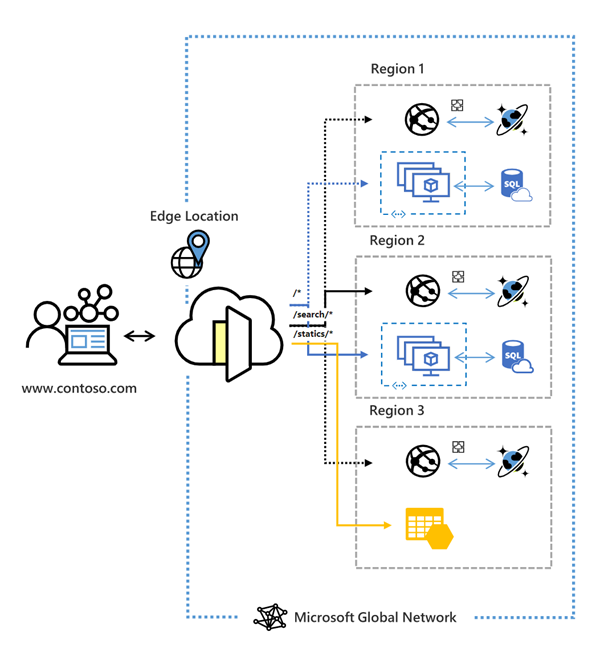
Traffic Manager
Azure Traffic Manager. is a DNS-based traffic load balancer that enables you to distribute traffic optimally to services across global Azure regions, while providing high availability and responsiveness. Traffic Manager provides a range of traffic-routing methods to distribute traffic such as priority, weighted, performance, geographic, multi-value, or subnet.
The following diagram shows endpoint priority-based routing with Traffic Manager:

For more information about Traffic Manager, see What is Azure Traffic Manager?
Load Balancer
Azure Load Balancer provides high-performance, low-latency Layer 4 load-balancing for all UDP and TCP protocols. It manages inbound and outbound connections. You can configure public and internal load-balanced endpoints. You can define rules to map inbound connections to back-end pool destinations by using TCP and HTTP health-probing options to manage service availability.
Azure Load Balancer is available in Standard, Regional, and Gateway SKUs.
The following picture shows an Internet-facing multi-tier application that utilizes both external and internal load balancers:

Application Gateway
Azure Application Gateway is a web traffic load balancer that enables you to manage traffic to your web applications. It's an Application Delivery Controller (ADC) as a service, offering various layer 7 load-balancing capabilities for your applications.
The following diagram shows url path-based routing with Application Gateway.
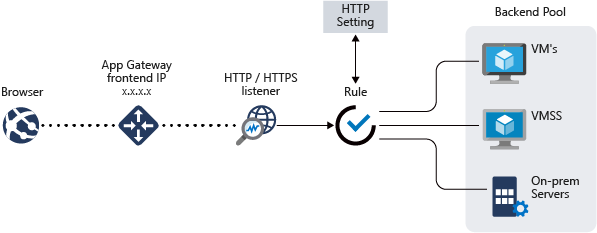
Content Delivery Network
Azure Content Delivery Network (CDN). offers developers a global solution for rapidly delivering high-bandwidth content to users by caching their content at strategically placed physical nodes across the world.

Network monitoring services
This section describes networking services in Azure that help monitor your network resources - Azure Network Watcher, Azure Monitor Network Insights, Azure Monitor, and ExpressRoute Monitor.
Azure Network Watcher
Azure Network Watcher provides tools to monitor, diagnose, view metrics, and enable or disable logs for resources in an Azure virtual network. For more information, see [What is Network Watcher?
Azure Monitor
Azure Monitor maximizes the availability and performance of your applications by delivering a comprehensive solution for collecting, analyzing, and acting on telemetry from your cloud and on-premises environments. It helps you understand how your applications are performing and proactively identifies issues affecting them and the resources they depend on. For more information, see [Azure Monitor Overview
ExpressRoute Monitor
To learn about how to view ExpressRoute circuit metrics, resource logs and alerts, see ExpressRoute monitoring, metrics, and alerts.
Network Insights
Azure Monitor for Networks (Network Insights). provides a comprehensive view of health and metrics for all deployed network resources, without requiring any configuration.
Next steps
- Create your first virtual network, and connect a few virtual machines to it, by completing the steps in the Create your first virtual network article.
- Connect your computer to a virtual network by completing the steps in the Configure a point-to-site connection article.
- Load balance Internet traffic to public servers by completing the steps in the Create an Internet-facing load balancer article.
Feedback
Coming soon: Throughout 2024 we will be phasing out GitHub Issues as the feedback mechanism for content and replacing it with a new feedback system. For more information see: https://aka.ms/ContentUserFeedback.
Submit and view feedback for
